Rejuvenation of Zr-Based Bulk Metallic Glasses by Ultrasonic Vibration-Assisted Elastic Deformation
Abstract
:1. Introduction
2. Experimental Methods
2.1. Sample Preparation
2.2. UVEF Processing
2.3. Hot-Compressed Elastic Deformation (HEF) Experiment
2.4. Analytical Testing
3. Results and Discussion
3.1. Thermodynamics Analysis
3.2. Macromechanics Analysis
3.3. Micromechanics Analysis.
3.4. Fracture Microtopography
3.5. Properties of the Hot-Compressed Elastic Deformation Treated Sample
3.6. Mathematical Model of the Relationship between Ultrasonic Amplitude And Free Volume
4. Conclusions
Author Contributions
Funding
Conflicts of Interest
References
- Inoue, A. Stabilization of metallic supercooled liquid and bulk amorphous alloys. Acta Mater. 2000, 48, 279–306. [Google Scholar] [CrossRef]
- Telford, M. The case for bulk metallic glass. Mater. Today 2004, 7, 36–43. [Google Scholar] [CrossRef]
- Demetriou, M.D.; Launey, M.E.; Garrett, G.; Schramm, J.P.; Hofmann, U.C.; Johnson, W.L.; Ritchie, R.O. A damage-tolerant glass. Nat. Mater. 2011, 10, 123–128. [Google Scholar] [CrossRef] [PubMed]
- Pan, J.; Ivanov, Y.P.; Zhou, W.H.; Li, Y.; Greer, A.L. Strain-hardening and suppression of shear-banding in rejuvenated bulk metallic glass. Nature 2020, 578, 559–562. [Google Scholar] [CrossRef] [PubMed]
- Deng, X.; Chen, S.; Hu, Q.; Xie, S.; Zou, J.; Sial, M.A.Z.G.; Zeng, X. Excellent room-temperature mechanical properties in the high glass-forming Zr−Cu−Ni−Al−Nb alloy system. Mater. Res. Express 2019, 6, 086551. [Google Scholar] [CrossRef]
- Schroers, J. Processing of Bulk Metallic Glass. Adv. Mater. 2009, 22, 1566–1597. [Google Scholar] [CrossRef]
- Zhang, T.; Meng, X.; Wang, C.; Li, L.; Yang, J.; Li, W.; Li, R.; Zhang, Y. Investigations of new bulk metallic glass alloys fabricated using a high-pressure die-casting method based on industrial grade Zr raw material. J. Alloys Compd. 2019, 792, 851–859. [Google Scholar] [CrossRef]
- Spaepen, F. A microscopic mechanism for steady state inhomogeneous flow in metallic glasses. Acta Met. 1977, 25, 407–415. [Google Scholar] [CrossRef]
- Nieh, T.; Schuh, C.; Wadsworth, J.; Li, Y. Strain rate-dependent deformation in bulk metallic glasses. Intermetallics 2002, 10, 1177–1182. [Google Scholar] [CrossRef]
- Saida, J.; Yamada, R.; Wakeda, M.; Ogata, S. Thermal rejuvenation in metallic glasses. Sci. Technol. Adv. Mater. 2017, 18, 152–162. [Google Scholar] [CrossRef] [Green Version]
- Tong, Y.; Iwashita, T.; Dmowski, W.; Bei, H.; Yokoyama, Y.; Egami, T. Structural rejuvenation in bulk metallic glasses. Acta Mater. 2015, 86, 240–246. [Google Scholar] [CrossRef] [Green Version]
- Liang, S.-X.; Jia, Z.; Liu, Y.-J.; Zhang, W.; Wang, W.; Lu, J.; Zhang, L. Compelling Rejuvenated Catalytic Performance in Metallic Glasses. Adv. Mater. 2018, 30, 223–234. [Google Scholar] [CrossRef] [PubMed] [Green Version]
- Raghavan, R.; Boopathy, K.; Ghisleni, R.; Pouchon, M.; Ramamurty, U.; Michler, J. Ion irradiation enhances the mechanical performance of metallic glasses. Scr. Mater. 2010, 62, 462–465. [Google Scholar] [CrossRef]
- Lee, M.-H.; Lee, K.; Das, J.; Thomas, J.; Kühn, U.; Eckert, J. Improved plasticity of bulk metallic glasses upon cold rolling. Scr. Mater. 2010, 62, 678–681. [Google Scholar] [CrossRef]
- Zhang, M.; Wang, Y.M.; Li, F.X.; Jiang, S.Q.; Li, M.Z.; Liu, L. Mechanical Relaxation-to-Rejuvenation Transition in a Zr-based Bulk Metallic Glass. Sci. Rep. 2017, 7, 625. [Google Scholar] [CrossRef]
- Guo, W.; Shao, Y.; Saida, J.; Zhao, M.; Lü, S.; Wu, S. Rejuvenation and plasticization of Zr-based bulk metallic glass with various Ta content upon deep cryogenic cycling. J. Alloys Compd. 2019, 795, 314–318. [Google Scholar] [CrossRef]
- Lee, S.-C.; Lee, C.-M.; Yang, J.-W.; Lee, J.-C. Microstructural evolution of an elastostatically compressed amorphous alloy and its influence on the mechanical properties. Scr. Mater. 2008, 58, 591–594. [Google Scholar] [CrossRef]
- Brechtl, J.; Wang, H.; Kumar, N.; Yang, T.; Lin, Y.-R.; Bei, H.; Neuefeind, J.; Dmowski, W.; Zinkle, S. Investigation of the thermal and neutron irradiation response of BAM-11 bulk metallic glass. J. Nucl. Mater. 2019, 526, 151771. [Google Scholar] [CrossRef]
- Ketov, S.V.; Sun, Y.H.; Nachum, S.; Lu, Z.; Checchi, A.; Beraldin, A.R.; Bai, H.Y.; Wang, W.H.; Louzguine-Luzgin, D.V.; Carpenter, M.A.; et al. Rejuvenation of metallic glasses by non-affine thermal strain. Nature 2015, 524, 200–203. [Google Scholar] [CrossRef] [Green Version]
- Guo, W.; Yamada, R.; Saida, J. Rejuvenation and plasticization of metallic glass by deep cryogenic cycling treatment. Intermetallics 2018, 93, 141–147. [Google Scholar] [CrossRef]
- Dmowski, W.; Yokoyama, Y.; Chuang, A.; Ren, Y.; Umemoto, M.; Tsuchiya, K.; Inoue, A.; Egami, T. Structural rejuvenation in a bulk metallic glass induced by severe plastic deformation. Acta Mater. 2010, 58, 429–438. [Google Scholar] [CrossRef]
- Chen, P.; Liao, W.-B.; Liu, L.H.; Luo, F.; Wu, X.Y.; Li, P.J.; Yang, C.; Yan, M.; Liu, Y.; Zhang, L.; et al. Ultrafast consolidation of bulk nanocrystalline titanium alloy through ultrasonic vibration. Sci. Rep. 2018, 8, 801. [Google Scholar] [CrossRef] [PubMed] [Green Version]
- Ma, J.; Liang, X.; Wu, X.; Liu, Z.; Gong, F. Sub-second thermoplastic forming of bulk metallic glasses by ultrasonic beating. Sci. Rep. 2015, 5, 17844. [Google Scholar] [CrossRef] [PubMed] [Green Version]
- Li, N.; Xu, X.; Zheng, Z.; Liu, L. Enhanced formability of a Zr-based bulk metallic glass in a supercooled liquid state by vibrational loading. Acta Mater. 2014, 65, 400–411. [Google Scholar] [CrossRef]
- Lou, Y.; Liu, X.; Yang, X.; Ge, Y.; Zhao, D.; Wang, H.; Zhang, L.-C.; Liu, Z. Fast rejuvenation in bulk metallic glass induced by ultrasonic vibration precompression. Intermetallics 2020, 118, 106687. [Google Scholar] [CrossRef]
- Wang, X.; Cao, Q.; Jiang, J.; Franz, H.; Schroers, J.; Valiev, R.; Ivanisenko, Y.; Gleiter, H.; Fecht, H.-J. Atomic-level structural modifications induced by severe plastic shear deformation in bulk metallic glasses. Scr. Mater. 2011, 64, 81–84. [Google Scholar] [CrossRef]
- Slipenyuk, A.; Eckert, J. Correlation between enthalpy change and free volume reduction during structural relaxation of Zr55Cu30Al10Ni5 metallic glass. Scr. Mater. 2004, 50, 39–44. [Google Scholar] [CrossRef]
- Dang, S.; Zhang, G.; Li, Z.; Yan, Z.; Li, Y.; Liang, W. Variation of microstructure of Zr60Al15Ni25 bulk amorphous alloy during rolling at room temperature. J. Alloys Compd. 2009, 479, L15–L17. [Google Scholar] [CrossRef]
- Hu, X.; Huang, L.; Zhang, W.; Xie, S.; Li, S. Effect of ultrasonic vibration on structure and micromechanical properties of a Zr-based bulk metallic glass. Mater. Eng. Powder Metall. 2017, 22, 15–19. [Google Scholar]
- Turnbull, D.; Cohen, M.H. On the Free-Volume Model of the Liquid-Glass Transition. J. Chem. Phys. 1970, 52, 3038–3041. [Google Scholar] [CrossRef]
- Qiao, J.; Pelletier, J.M.; Kou, H.; Zhou, X. Modification of atomic mobility in a Ti-based bulk metallic glass by plastic deformation or thermal annealing. Intermetallics 2012, 28, 128–137. [Google Scholar] [CrossRef]
- Schuh, C.; Hufnagel, T.C.; Ramamurty, U. Mechanical behavior of amorphous alloys. Acta Mater. 2007, 55, 4067–4109. [Google Scholar] [CrossRef]
- Jun, H.-J.; Lee, K.; Yoon, S.; Kim, H.S.; Chang, Y. Finite-element analysis for high-temperature deformation of bulk metallic glasses in a supercooled liquid region based on the free volume constitutive model. Acta Mater. 2010, 58, 4267–4280. [Google Scholar] [CrossRef]
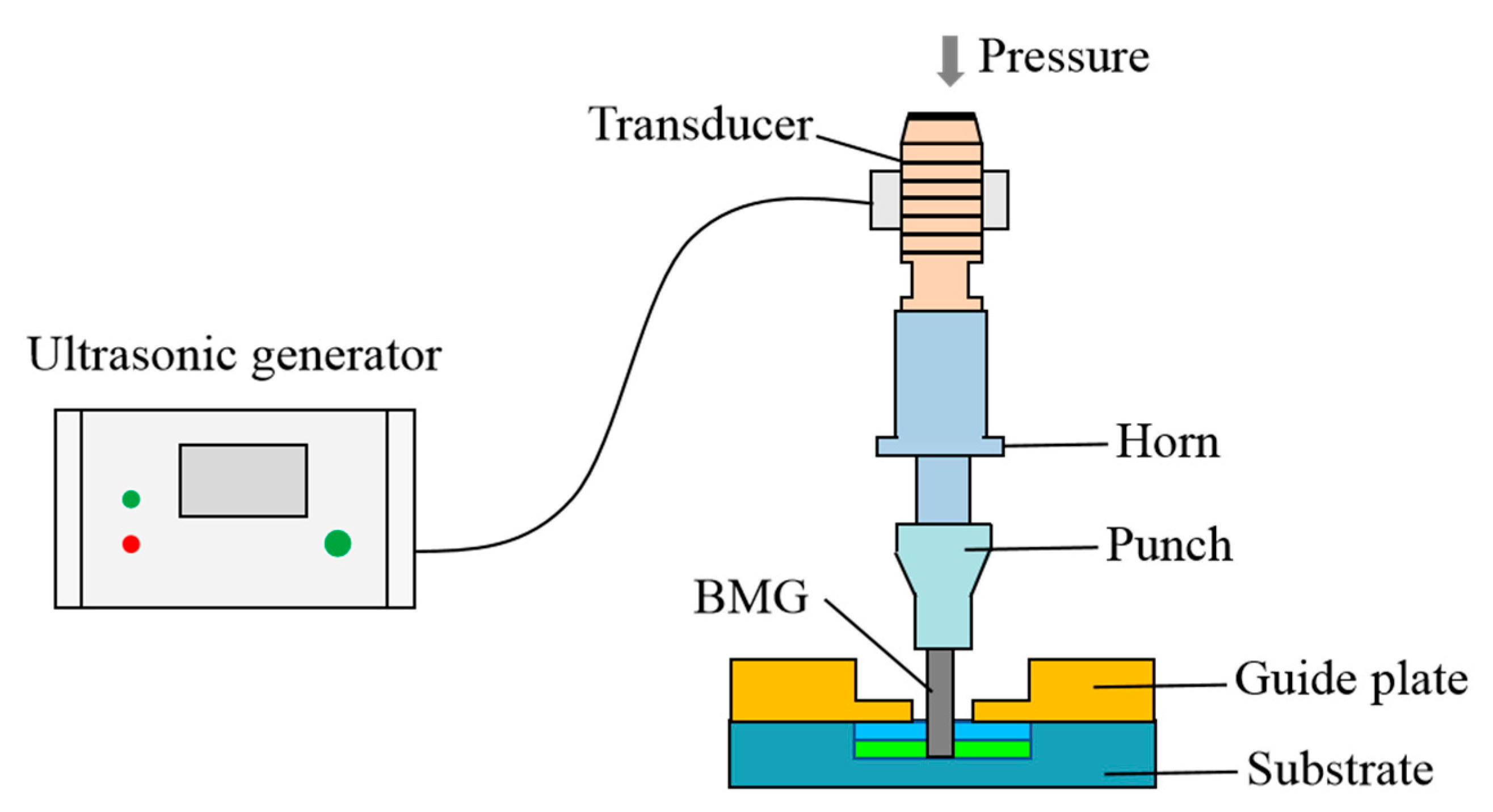
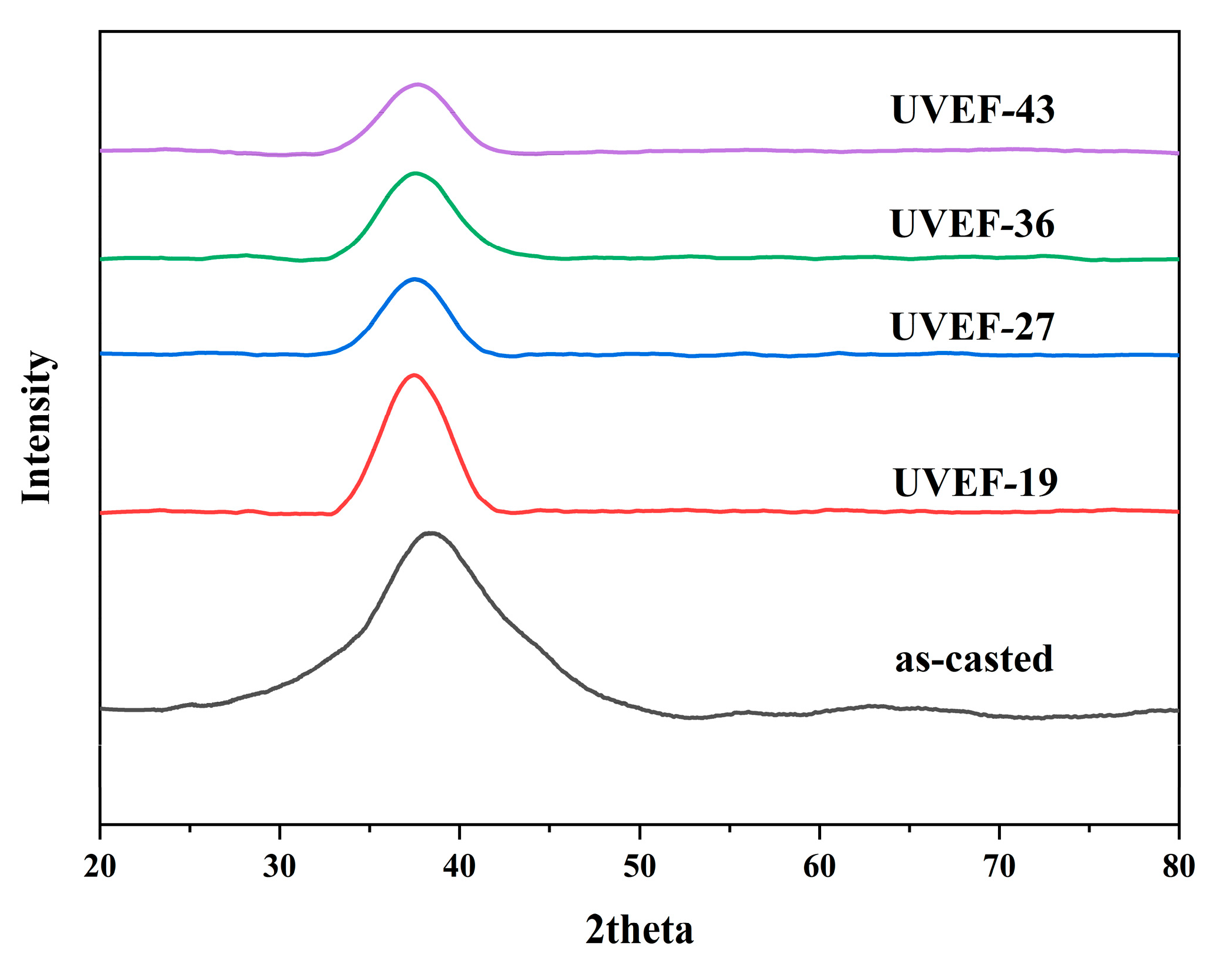
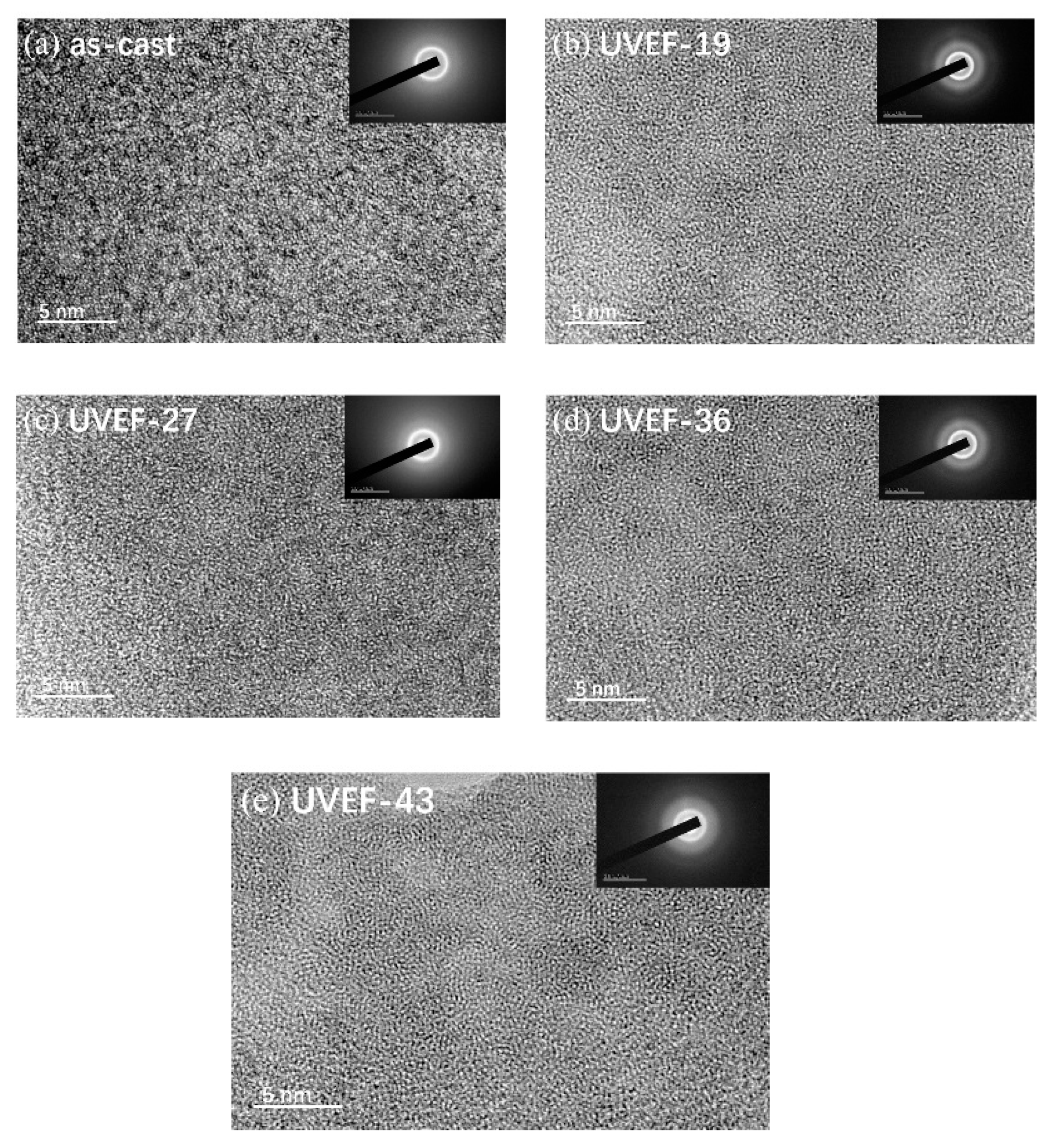
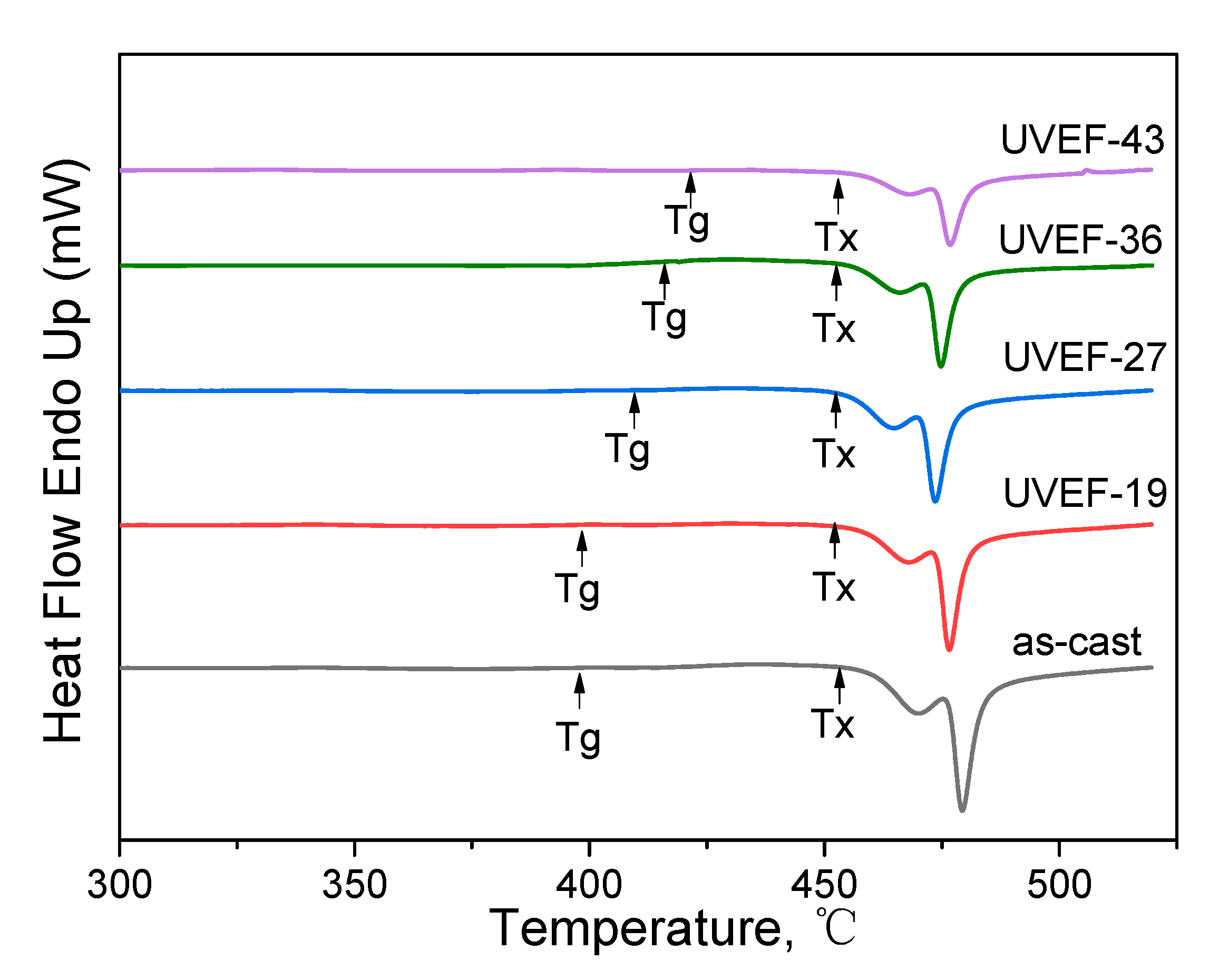
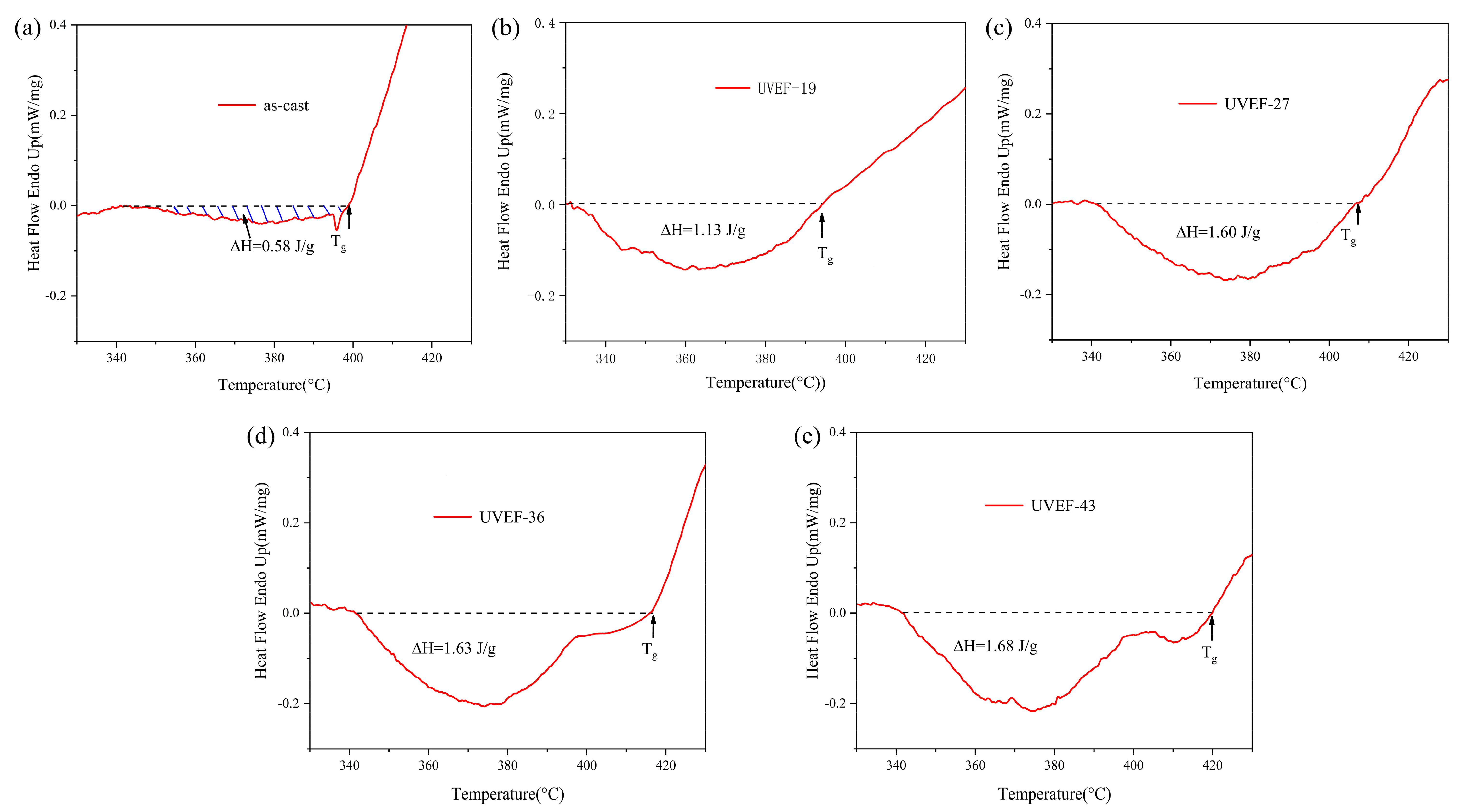
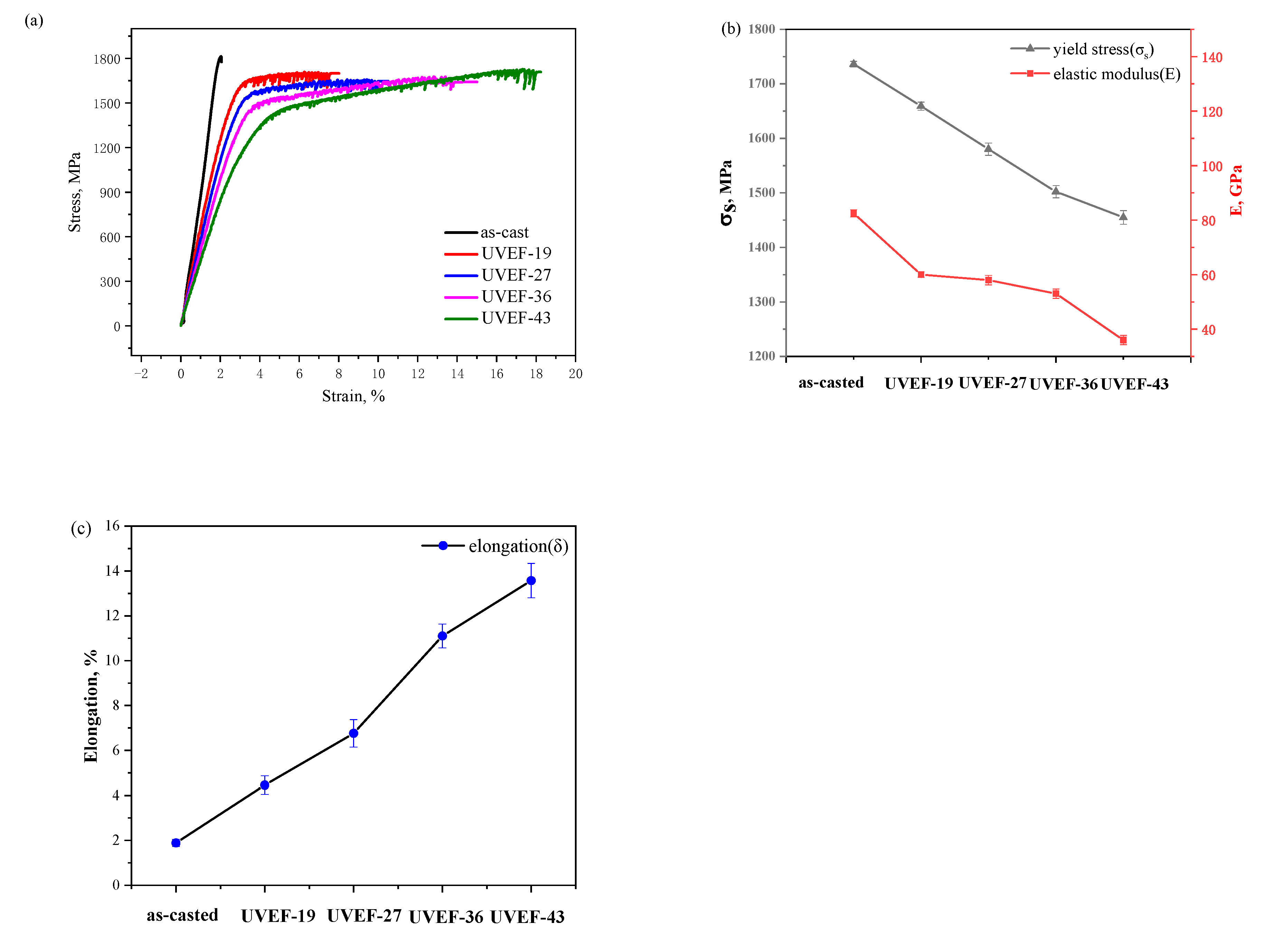
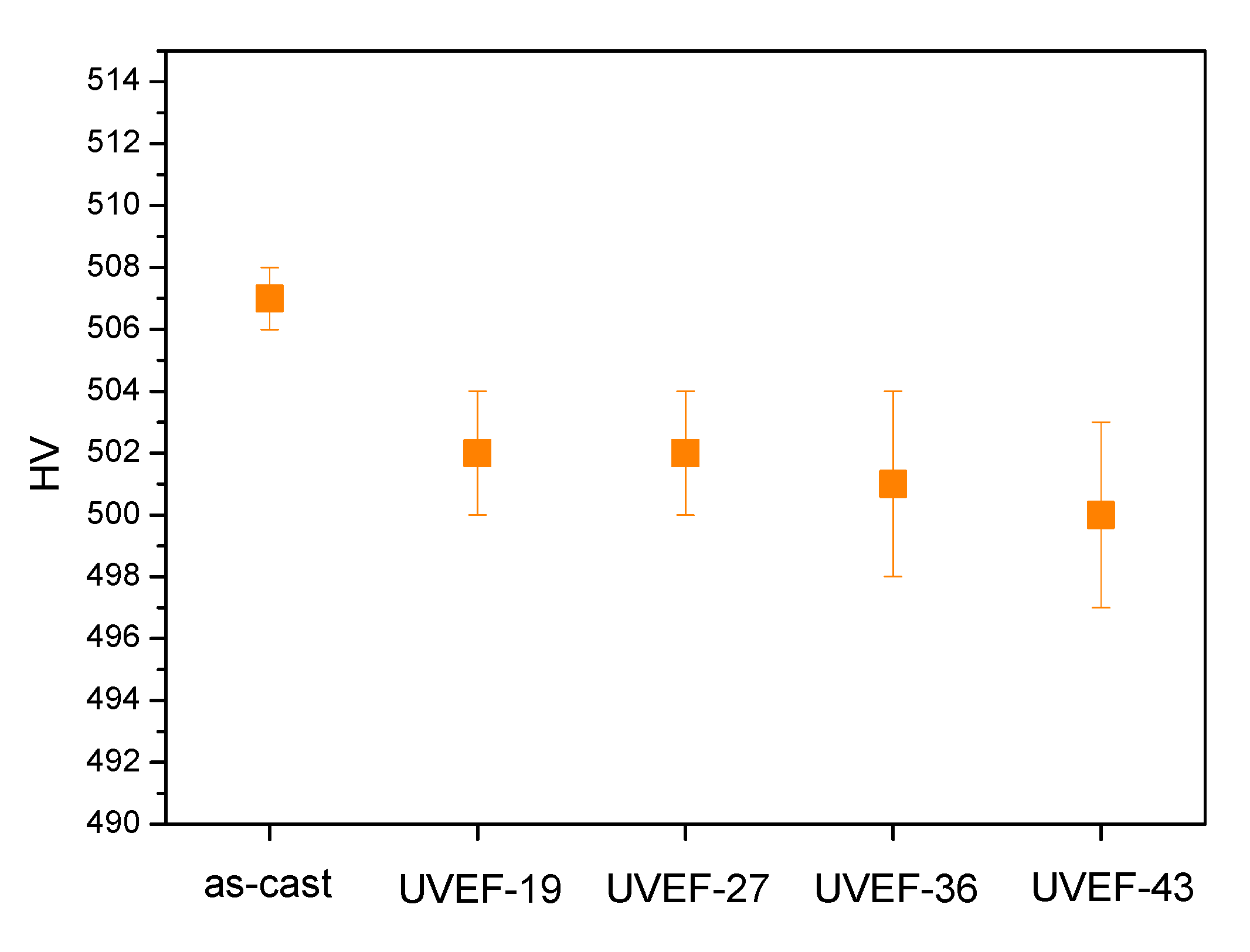

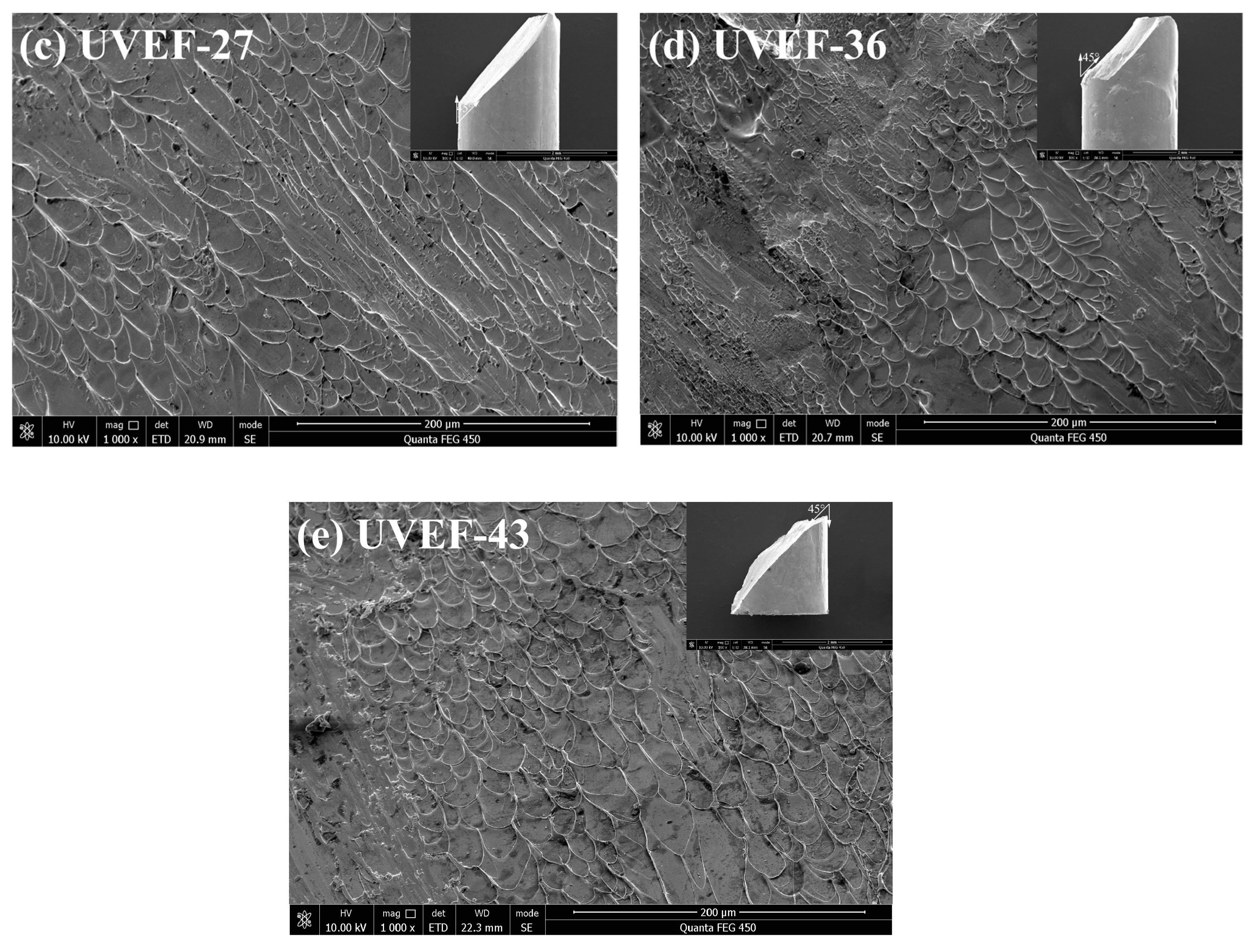
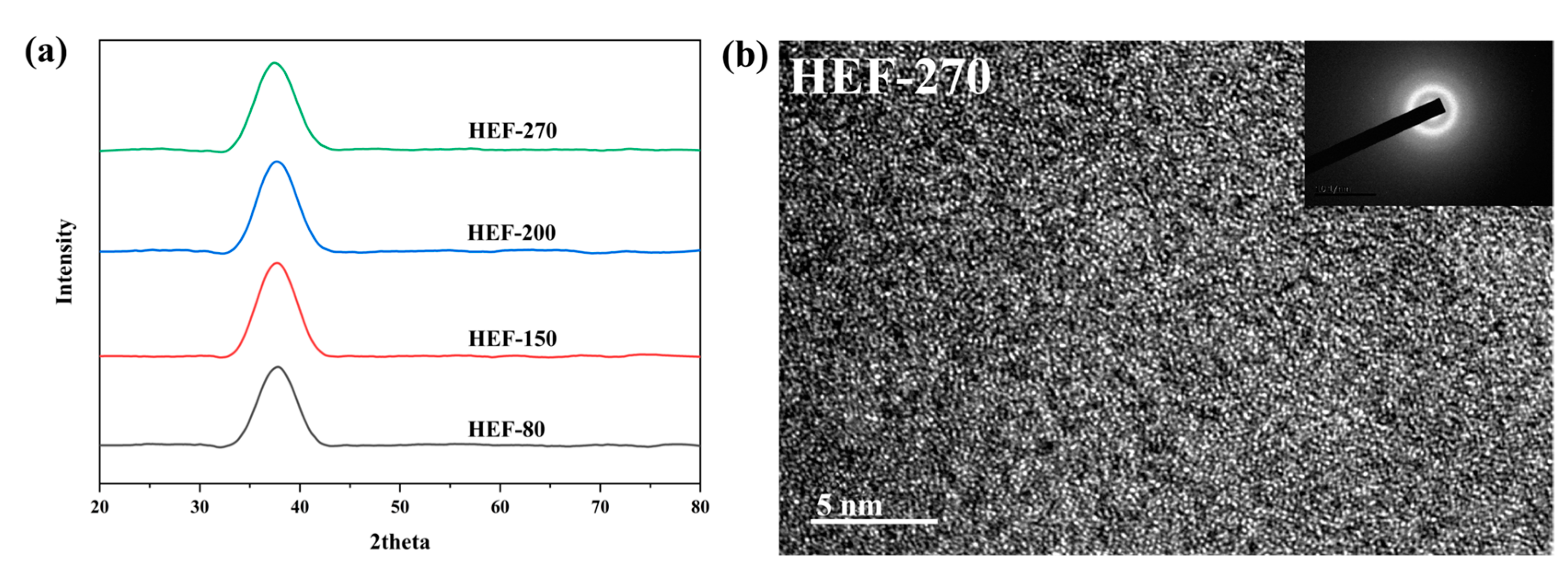

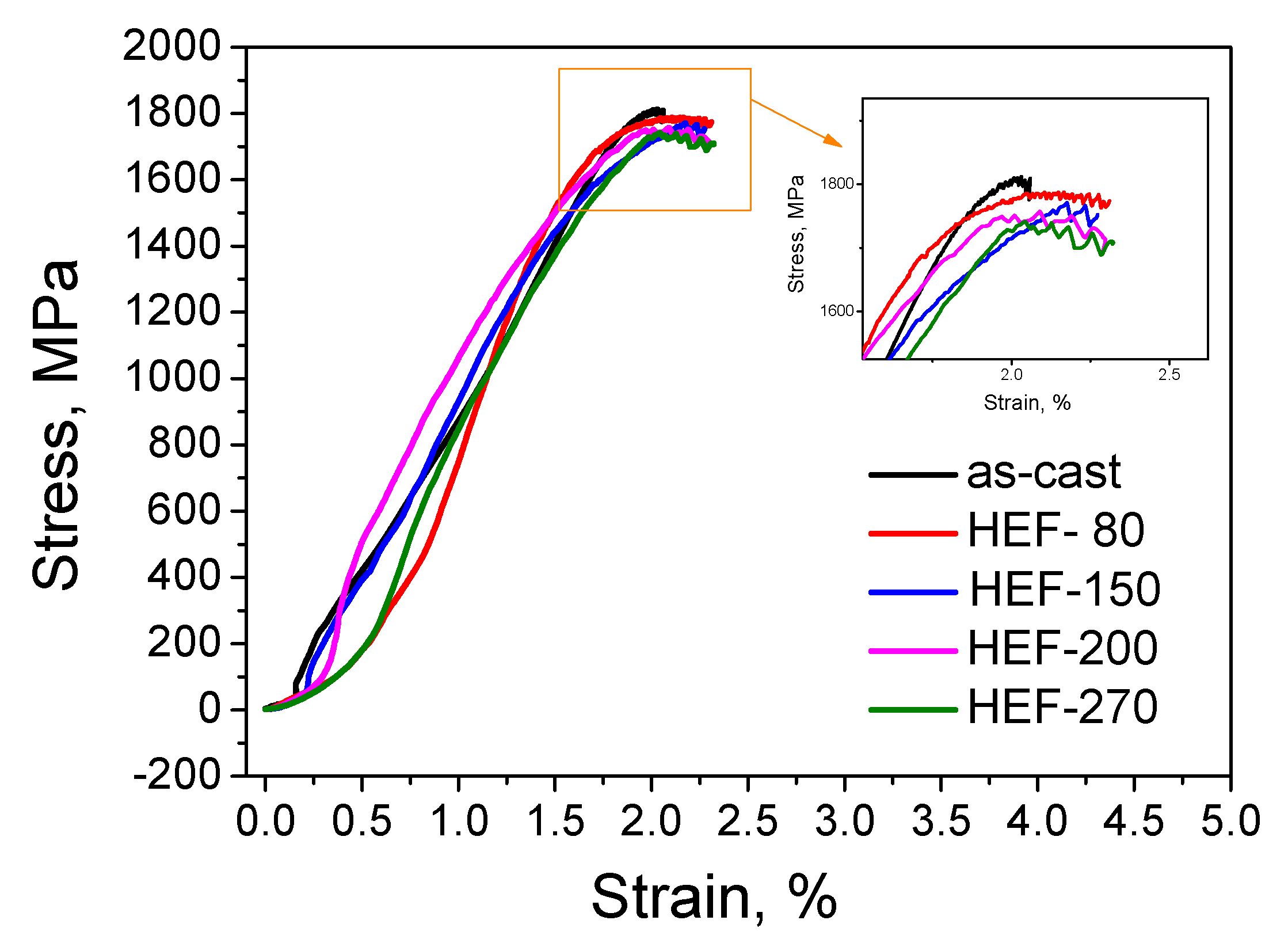
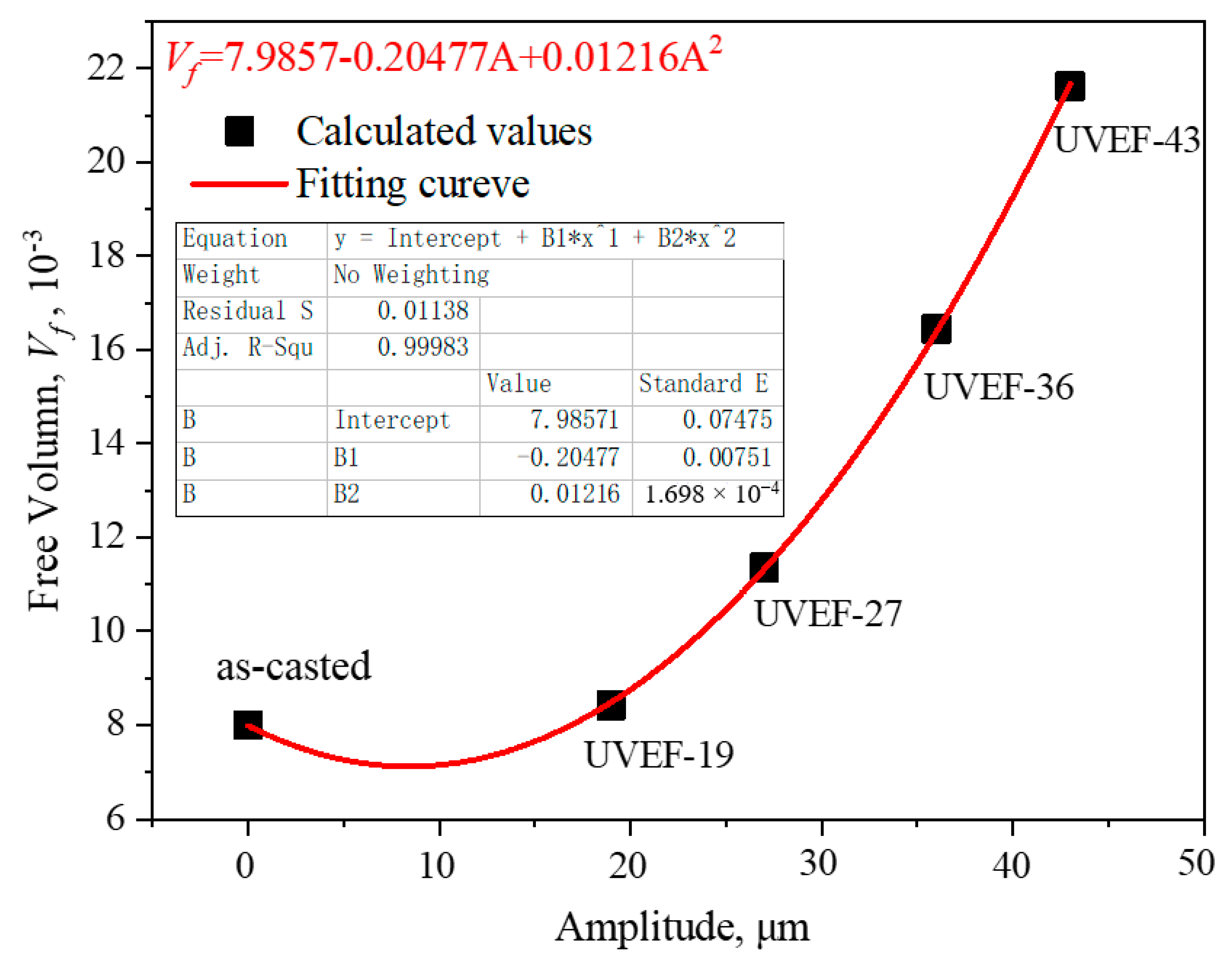
| Sample | Tg (K) | Tx (K) | ΔT (K) |
|---|---|---|---|
| As-cast | 397 | 452 | 55 |
| UVEF-19 | 398 | 452 | 54 |
| UVEF-27 | 410 | 453 | 43 |
| UVEF-36 | 416 | 453 | 37 |
| UVEF-43 | 422 | 454 | 32 |
© 2020 by the authors. Licensee MDPI, Basel, Switzerland. This article is an open access article distributed under the terms and conditions of the Creative Commons Attribution (CC BY) license (http://creativecommons.org/licenses/by/4.0/).
Share and Cite
Lou, Y.; Xv, S.; Liu, Z.; Ma, J. Rejuvenation of Zr-Based Bulk Metallic Glasses by Ultrasonic Vibration-Assisted Elastic Deformation. Materials 2020, 13, 4397. https://doi.org/10.3390/ma13194397
Lou Y, Xv S, Liu Z, Ma J. Rejuvenation of Zr-Based Bulk Metallic Glasses by Ultrasonic Vibration-Assisted Elastic Deformation. Materials. 2020; 13(19):4397. https://doi.org/10.3390/ma13194397
Chicago/Turabian StyleLou, Yan, Shenpeng Xv, Zhiyuan Liu, and Jiang Ma. 2020. "Rejuvenation of Zr-Based Bulk Metallic Glasses by Ultrasonic Vibration-Assisted Elastic Deformation" Materials 13, no. 19: 4397. https://doi.org/10.3390/ma13194397




